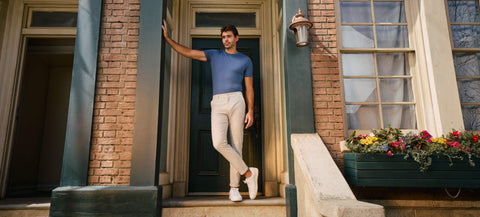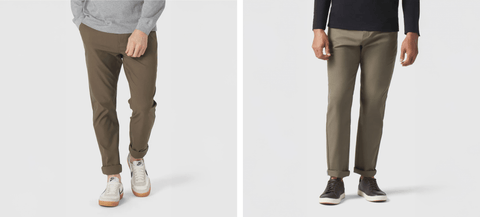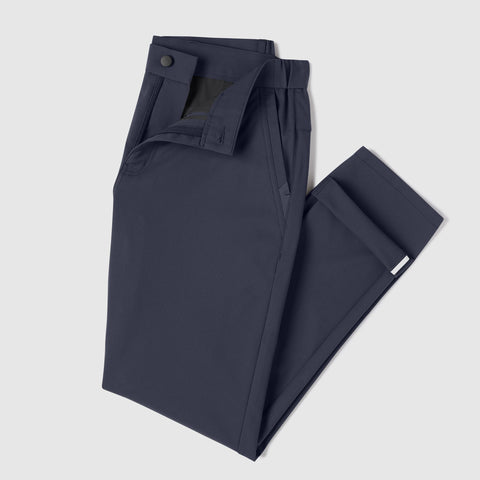You're looking in the mirror. Your outfit is complete. The shirt, the jacket, the pants, the shoes…the ensemble looks okay.
But in the back of your mind, there's this little voice of doubt.
It's saying, "Why don't I look as good as Chris, my outrageously fashionable and well-compensated coworker?"
You swap your jacket. You re-comb your hair. You put on some sunglasses. You try everything, and you still can’t quite nail that effortless style.
What's the problem?
Many of us guys aren't well-versed in how to dress. The good news is that you can easily learn how to elevate your personal style. And your education starts today.
In this guide, we're serving up the ultimate dress code for men's fashion — from choosing the right fit to jazzing up your look with accessories.

The fundamentals of style for men: 7 essential tips
Style is a very personal thing. An outfit that looks sensational on one guy will look weird on someone else.
That said, some fundamental rules apply to everyone. Here are the style commandments you need to drill into your brain:
1. Fit is everything
Brand doesn't mean anything. Price is irrelevant.
If you want to look good, finding the right fit is your top priority.
Think about it: Buying a $2,000 Versace suit that sags around your ankles is just an expensive way to look like a kid wearing his dad’s clothes.
Obviously, picking up something tailored is the ideal scenario. But in many cases, you don't need to go premium. It's more about identifying fits that flatter your body shape and match your personal style.
For instance, baggy pants might be fine if you're trying to impress Avril Lavigne — but they're not going to make you look professional at work. And you probably wouldn't wear them for cocktails.
Here are some tips on finding your fit:
-
Know your measurements: Get professionally measured for your chest, waist, inseam, and neck size. Guessing leads to bad fits.
-
Slim vs. regular fit: If you’re lean, opt for slim-fit clothing to avoid looking like you’re swimming in fabric. If you’re stockier, go for regular or tailored fits that skim your body without clinging.
-
Shoulders first: For jackets and shirts, the shoulder seams should align with the edge of your shoulders. If it’s too tight or drooping, it’s not the right size.
-
Pants length matters: Your pants should break (slightly fold) at the top of your shoes. Too long, and you’ll look sloppy. Too short, and you’re in "flooding" territory — a.k.a. flaunting your ankle cleavage.
-
Avoid baggy clothes: Baggy doesn’t mean comfortable — it just makes you look bigger or untidy. Opt for clothes that follow the natural lines of your body.
-
Balance proportions: If you’re tall and thin, avoid overly slim fits that make you look lanky. If you’re shorter, bear in mind that long shirts and jackets make your legs look shorter.
Our Jetsetter Tech pants come in Slim and Straight fits, so you can choose the option that complements your physique. Both options look tailored, thanks to smart design — including that all-important butt-lifting technology.
2. Create outfits around color combinations
Color is an important part of personal style. Mix and match hues properly, and you'll look really stylish. Get it wrong and you turn into a walking Jackson Pollock.
(We're guessing you're not into the "abstract expressionist" look. Because that's not a thing.)
To avoid this embarrassing fate, it's worth taking a moment to study color theory.
Don't worry, this isn't an art history class. The key is to recognize which colors work with each other. Here are some pairings to start you off:
-
Deep blue and tan: Classic and refined, this combo is the fashion equivalent of a well-aged bottle of whiskey — smooth, sophisticated, and always in style.
-
Black and white: The original power couple. This timeless pairing says, “I know fashion," without transmitting any unwanted sense of vanity.
-
Olive green and brown: Think of this earthy duo as smart-casual camouflage. You won't stand out, but those who look carefully will admire your disguise.
-
Charcoal gray and burgundy: This sumptuous duo looks great when you're wearing a suit or something dressy. It's like a velvet armchair next to a smoldering fireplace.
-
Blue and white: If you want to feel like a walking breath of sea spray, this is the color combo for you.
-
Marine blue and blush pink: Sweet yet serious, this pairing will win over your date. It can also elevate your look in the boardroom beyond the usual boring monotones.
-
Mustard and dark gray: Feeling confident? This sizzling duo is the fashion equivalent of a cheeky wink.

The common theme here is controlled contrast. If you want to wear one bold color, pair it with something more muted.
When in doubt, just combine garments with different shades of the same color family (e.g., navy and light blue).
3. Prioritize quality over quantity
You don't need to buy many items to have a complete wardrobe. You just need to find garments that will stand the test of time. This means prioritizing quality when you go shopping.
Think ahead, two years from now. Will you remember $15 either way on a pair of pants? Probably not. But if you invest, you'll appreciate the improved fit and comfort every time you put them on.
Similarly, cheap suits are like bad toupees — everyone can tell, but nobody wants to say anything.
Just as importantly, high-quality garments tend to look better for longer…and they definitely won't fall apart at the seams.
4. Dress for the occasion
What makes men's fashion confusing is that the rulebook is flexible. An outfit that looks perfect in one situation looks ridiculous in another setting. Showing up to a black-tie event in flannel is like bringing a kazoo to a symphony. You'll definitely stand out, but not in a good way.
This is one of the more obvious examples, of course. But there are many different dress codes. If you want to navigate them seamlessly, it's worth getting to know the most common ones ahead of time:
-
Smart casual: A well-fitted blazer over a crew-neck T-shirt or a button-up shirt with Jetsetter Tech pants will make you look like you’ve got your life together. Bonus points for loafers or smart boots on your feet.
-
Business casual: We're aiming for the sweet spot between “I’m here to work” and “I don’t live for the office.” Go for a crisp shirt with well-tailored trousers, but skip the tie. Add a jacket or blazer if you’re feeling ambitious.
-
Formal: Time to break out your suit and tie. Polish your dress shoes, and make sure your trousers break just above your shoes for a clean silhouette.
-
Black tie: When you’re invited to a fancy gala, the tuxedo isn’t optional. Don't even think about anything other than a black suit with a crisp white shirt. Just make sure your bow tie is straight.
-
Cocktail party: Halfway between a formal event and a fun night out. Choose a sleek suit, but feel free to mix things up with a bit of flair — perhaps a velvet jacket or a colorful tie.
-
Loungewear: You’re home, you’re comfortable, and you’re not ashamed of it. But let’s not mistake this for “staying in pajamas all day” territory. Think nice joggers and a simple sweater or hoodie.
Challenge: Take a look in your wardrobe and try to put together outfits that match each of these codes. Can't quite do it? We'll help you upgrade your wardrobe later!
5. Master the art of layering
As every mountain guide will tell you, layering is great for regulating your temperature. But it's also an important pillar of dressing fashionably.
Putting a thick jacket under a lightweight coat makes you look like a Michelin man. And wearing a long T-shirt beneath a short sweater is just plain weird.
If you want to look good, remember the rule: thinner to thicker, shorter to longer.

You can also use layers to show off some of those color combinations we mentioned earlier. A blue button-up sweater over a white T-shirt looks great, for example.
6. Don't overlook footwear
The average man knows only three categories of shoes: smart, smart-casual, and sneakers.
You may be surprised to learn that footwear is actually a little more nuanced. Switching from one style to another can completely change your overall look and how you’re perceived — much like a bumper sticker on your rear windshield.
Here are some common examples:
-
Loafers: Suave, yet relaxed. They work for everything from smart casual to business casual, pairing with Jetsetters, chinos, or even a well-fitted suit. Just don’t wear them with shorts unless you're really comfortable in your own skin…
-
Derbies: The laid-back smart shoe. Go for brown if you want to look approachable, or black if you're planning to conquer the corporate realm.
-
Oxfords: The Mr. Darcy of footwear. Refined, serious, and about as sophisticated as shoes can get. If you’ve got a black tie event or an important business meeting, put on your Oxfords.
-
Chelsea boots: Perfect for fall or winter when you need a bit of rugged sophistication. Pair them with slim-fit jeans or Jetsetters, and a jacket, and suddenly you look like you’ve just come from a trendy coffee shop.
-
Desert boots: The slightly cooler, more laid-back cousin of the Chelsea boot. Match them with jeans or Jetsetters, and you’ve got a relaxed yet thoughtful vibe.
-
Brogues: With their perforated detailing, brogues add a touch of flair to an otherwise classic look. They pair nicely with suits, but they shine even more when paired with jeans or Jetsetters.
-
Trainers or sneakers: Choose wisely. The wrong sneakers can make you look like you’ve just rolled out of bed. But the right ones? Well, they’ll elevate your whole outfit. Go for minimalistic, clean designs (think white leather or neutral tones) if you're going for a more refined, street-ready vibe.
You don't need to get shoes for every category. As with the rest of your wardrobe, try to collect options that cover most looks and occasions.
7. Accessorize for a different vibe
Cuff links. A watch. A metal bracelet on your wrist. Your gleaming belt buckle.
These details might seem small and insignificant, but they all reveal something about you — and alter how people perceive your sense of style.
Here's what the following accessories say about you:
-
Classic watch: I'm punctual, sophisticated, and smart enough to read an analog clockface.
-
Digital watch: A practical man, who's grown up enough not to use a phone for timekeeping.
-
Timeless leather belt: I understand the value of quality and keeping my pants from falling down.
-
A huge buckle: I want people to look at my crotch.
-
Aviator sunglasses: I'm either Maverick, or I've just watched too much Top Gun.
-
Wayfarer sunglasses: Is that Leonardo DiCaprio?
-
Pocket square: I've got taste, and I'm not afraid to show it.
-
Cufflinks: This guy pays attention to the details.
-
Scarves: I don't like a cold neck, and I'm happy to use my temperature preferences as a fashion statement.
-
Rings: Who is this mysterious character?
-
Fedora hat: I'm on my way to a Magic: The Gathering expo.

In other words, be conscious of the accessories you wear. And use them to make a personal style statement!
How to identify your personal style
Speaking of personal style…what's yours?
You don't necessarily need to come up with a name. But having a trademark look can help guide your shopping and how you dress. Plus, every office needs a style icon.
Here's how to pinpoint your look:
-
Recognize what you hate. What style or type of garment makes your eyeballs itch? There's no need to force anything into your wardrobe; we can simply cut out some options.
-
Pick out your favorites. Next, think about what you love to wear. This shouldn't necessarily be your "comfort zone." Be brave, and choose what makes you feel like a million bucks.
-
Identify examples that match your taste. It could be a celebrity or someone you know. Either way, take a closer look at what they wear and make notes.
-
Think about your lifestyle. Which environments and social situations do you encounter in the average month? Given that you want to dress appropriately for every occasion, it's important to build a style that can handle your social calendar.
-
Get real about fits and colors. Even if you wanted to look like Beyoncé, you might struggle to pull it off with that physique. Your personal style must match who you are, not the other way around.
With this collection of preferences, you should be much closer to finding your signature look. All that remains is to experiment. Double down on styles you love, and slingshot everything else toward the nearest star.
Building a functional wardrobe
Houston, we have a problem. You've identified your personal style, and there are some major gaps in your wardrobe.
Guess you'll just have to do a little shopping. Here's how to come home with the right stuff:
1. Assess your wardrobe
Pull out all the drawers and figure out what works with your newly identified style.
At the same time, try to find the gaps and make a list. You don’t need to include every cool thing under the sun — focus on items you're likely to wear often. You know… smart casual pants that won't crush your balls, a solid pair of jeans, several different colors of T-shirts, and shoes that look the part.
2. Think in terms of full outfits
Don’t just buy individual pieces. Picture how every item fits into a full outfit.
That Space Black jacket? Superb. But do you have pants or shirts to go with it? If not, it’s just a piece of wishful thinking.
Your wardrobe should be a cohesive collection, not a jumble of one-off items that look good on their own but fail to pull together.
3. Shop 'til you drop
Okay, maybe don't make it an endurance event. But now it’s time to hit the shops or online retailers and fill in those gaps.
Stick to your list and avoid impulse buys. You’re building a functional wardrobe, not shopping for the end of days. Your future self (and bank balance) will thank you.
Upgrade your wardrobe today
Dressing well doesn't have to be hard work. You don't need a Vogue subscription. And you certainly don't need to spend every weekend at the mall.
But if you put in a little bit of thought today, you can set a stylish foundation for years to come.
Remember, if you're looking for high-quality garments that you can wear all day long, our Jetsetter Tech pants are definitely worth your attention. They're comfy, durable, and beautifully designed. Check them out here!


![What Pants Should You Wear With a Denim Shirt? [Men's Fashion Guide]](http://www.jackarcher.com/cdn/shop/articles/00_JackArcher_What-pants-to-wear-with-a-denim-shirt-1.jpg?v=1737604544&width=480)
























